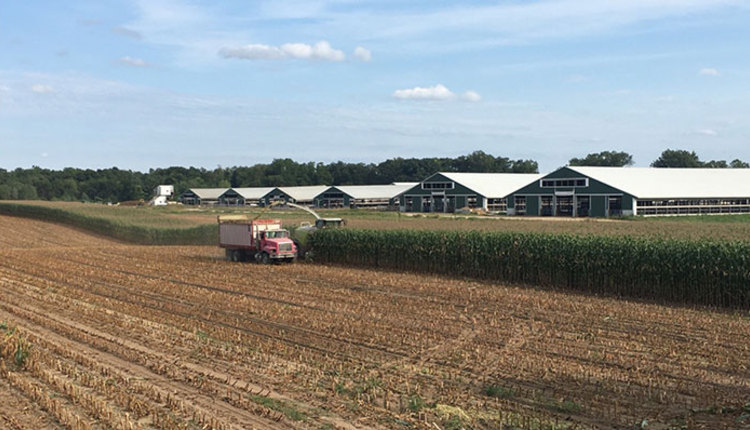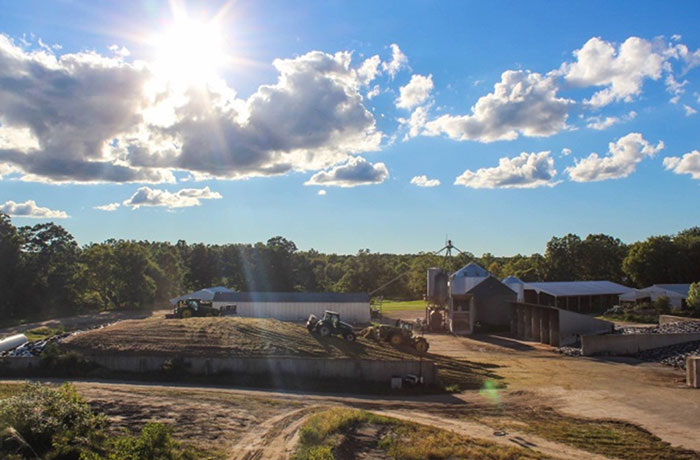They focus on consistent, digestible forages |
| By Mike Rankin, Managing Editor |
|
|
 Harvesting high-quality forage is a challenge. Consistently harvesting high-quality forage is . . . well . . . an even bigger challenge. Some operations seem to have largely mastered the latter hurdle, mostly with extreme attention to detail and an unending drive to look for the weakest link and make it better. Sand Creek Dairy in Hastings, Mich., is one of those farms. Luke Haywood and his son, Ethan, recently shared their recipe for forage production success on the Dairy Forage Seminar stage at the World Dairy Expo in Madison, Wisconsin. The farm is a frequent high finisher in the World Forage Analysis Superbowl contest. Currently, three generations own and operate Sand Creek Dairy with Ethan being a member of the sixth generation. The farm has been at the same location for 100 years. These days, the Haywoods are milking 1,200 Holstein and Jersey cows. Their Holsteins average 32,585 pounds of milk, 1,213 pounds of butterfat, and 1,007 pounds of protein. The Jerseys average 22,296 pounds of milk, 1,087 pounds of butterfat, and 823 pounds of protein. “Our focus is on milk protein,” Ethan said. “That’s why we feed a lot of forages and why we’ve incorporated Jerseys into the herd.” “We’re in the business of making milk,” Luke explained. “So, our cropping goals are such that we want to produce the highest quality and quantity of digestible nutrients we can. We largely focus on corn silage because it provides a consistent and repeatable feed year after year.” The milking-cow diet at Sand Creek Dairy consists of 20 to 25 pounds of corn silage dry matter and 5 to 10 pounds of alfalfa haylage being fed per day. Recently, they have also been growing some highly digestible grass forage to work into the ration. The Haywoods farm sand, clay, and muck soils, utilizing both irrigation and subsurface drainage tile based on need. Many of their fields are relatively small.  Ethan and Luke Haywood Want milk, not manure “Over the past 20 years, we’ve really focused on NDFD (neutral detergent fiber digestibility) when it comes to selecting forage hybrids and varieties,” Luke emphasized. “We want feed that translates into milk rather than manure. Cows digest cellulose and hemicellulose, not lignin. Then on the cow side, we’re selecting for high feed efficiency,” he added. “Most of the forages we grow have a reduced-lignin content,” Luke said. “We plant both brown midrib (BMR) corn hybrids and reduced-lignin alfalfa varieties for our lactating cows.” With the HarvXtra-traited alfalfa, the Haywoods maintain a 26- to 28-day cutting schedule rather than trying to achieve greater yields with a longer interval. They generally get five to six cuttings, and their 600 acres of alfalfa are typically mowed in a three-day window. Most of their alfalfa land is on marginal soils where the risk of ensuring a good corn crop is higher. “Although we want highly digestible forages, we also don’t want to give up too much yield on our limited acres, so it becomes a bit of a juggling act,” Luke said. “Most of our corn silage acreage is irrigated to help ensure consistent performance.” The Haywoods do a lot of on-farm testing of hybrids and varieties and are open to putting multiple genetics in the same field, then harvesting, sampling, and weighing them separately to determine overall performance. “We want to know how something will yield and test in our environment,” Ethan said. In recent years, the Haywoods have started to grow some alternative grass forages. When river bottom land has flooded out early in the season, they have had good success planting sorghum forage to help bolster forage inventories. They are also growing Italian ryegrass, which is being utilized in lactating-cow diets as a highly digestible feed. Cereal rye is another grass that is being seeded and harvested on some fields. Vigilant crop monitoring The Haywoods do grid soil sampling every three years on their fields. They test their manure prior to application to know exactly what is being applied in terms of nutrients. Prior to sidedressing nitrogen on their corn, they do a presidedress nitrogen test (PSNT) to account for any residual nitrogen in the soil. Once nitrogen is applied, the Haywoods continue to keep close tabs on the crop. They will do plant tissue testing in situations where they think a nutrient deficiency might be a problem, and they routinely apply foliar fungicide to all of their BMR corn fields. As it has for many corn growers in the Midwest, tar spot has become a new foliar disease challenge for the Haywoods. Fertigation is used to apply any nitrogen that might be needed after the corn is too tall for a ground application. Luke also noted that they will do late-season stalk nitrate tests to gauge whether their corn crop got too much or too little nitrogen. Avoid storage shortcuts The Haywoods have about 12 different bunker silos that they use to inventory feeds by type and quality. For example, they grow conventional (non-BMR) corn for dry cows and heifers, which must be stored separately. “We run four packing tractors per chopper,” Ethan said. “Adequate packing is really a high priority for us, even if it takes more money and labor to get the job done. We want one of the packing tractor drivers to stop and check kernel processing at least once per hour. It’s also important that we cover a filled and packed bunker the same day,” he added.  The Haywoods apply bacterial inoculants on all of their stored forages, use tires to cover every square inch of the bunker, and place gravel bags along the four sides. They now use a single layer covering that has oxygen exclusion properties. “At the end of the day, we’re trying to produce feed that will support and maintain a high level of milk production,” Luke said. “The key to that end is our forage management program.” It all seems to be working at Sand Creek Dairy, but be assured the Haywoods will never let up on the gas pedal as they strive for even better results and profitability. |
